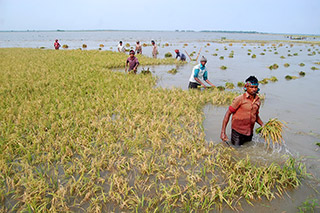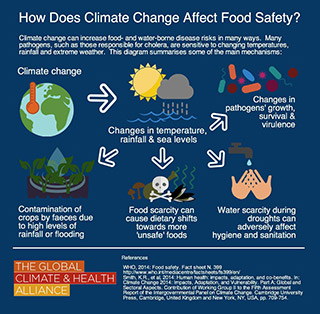Climate Change and Human Health

Climate change is impacting our global food system in a variety of direct and indirect ways and presenting new challenges to food safety and human health.
Changes in temperature and precipitation can affect the distribution and survivability of pathogens that cause foodborne illnesses1 . Changes in climate can cause severe droughts or flooding. These events can in turn affect pathogens and introduce toxins to crops. Ingestion of food contaminated with pathogens can result in foodborne illnesses, such as norovirus infection or salmonellosis.
Climate change is also projected to affect the quality of food. The increase in atmospheric carbon dioxide associated with climate change can affect the nutritional value of staple crops and exacerbate malnutrition by reducing protein content and essential minerals2 , 3 .
Food Safety and Nutritional Impacts on Human Health

Food safety refers to the conditions and processes throughout the food system that ensure food is safe for human consumption. Globally, about one in 10 people become ill with a foodborne illness, and over 420,000 deaths occur every year4 .
Changes in air and water temperatures can modify the seasonal and geographic occurrence of bacteria, viruses, parasites, fungi, and pests as well as chemical contaminants. Higher temperatures can increase the number of pathogens already present on produce and seafood, while bacterial populations can increase during food storage which, depending on time and temperature, can also raise food spoilage rates5 .
According to the Food and Agriculture Organization of the United Nations, 800 million people are undernourished, while 76% of the global population gets most of its daily nutrients from plants6 . Droughts and flooding exacerbated by climate change can impact the staple crops that these populations subsist on. The impacts of climate change on food systems can affect everyone, but some groups are more vulnerable. Women, children, older adults, low-income populations, Indigenous Peoples, and small-scale food producers more often experience malnutrition7 , 8 .
Opportunities for Public Health Improvement
Promoting sustainable climate-focused agricultural practices, such as crop rotation and drip irrigation, can help safeguard food safety. Adapting crop management, crop diversification, and food storage, supply, and distribution infrastructure to promote food safety can reduce contamination of food by pathogens and toxins.
Research Opportunities
Research is needed to better assess the effects of climate change on food production, availability, and contamination as well as the associated linkages to project the impacts of rising temperatures, drought, and flooding that can improve food safety. Additionally, the projected human health impacts of increased carbon dioxide on the nutritional value of plants are not as well understood and requires further study.
-
Ziska, L., A. Crimmins, A. Auclair, S. DeGrasse, J.F. Garofalo, A.S. Khan, I. Loladze, A.A. Pérez de León, A. Showler, J. Thurston, and I. Walls, 2016: Ch. 7: Food Safety, Nutrition, and Distribution. The Impacts of Climate Change on Human Health in the United States: A Scientific Assessment. U.S. Global Change Research Program, Washington, DC, 189–216. [Full Text Ziska, L., A. Crimmins, A. Auclair, S. DeGrasse, J.F. Garofalo, A.S. Khan, I. Loladze, A.A. Pérez de León, A. Showler, J. Thurston, and I. Walls, 2016: Ch. 7: Food Safety, Nutrition, and Distribution. The Impacts of Climate Change on Human Health in the United States: A Scientific Assessment. U.S. Global Change Research Program, Washington, DC, 189–216.]
-
Harvard C-Change Center for Climate, Health, and the Global Environment. Climate change puts at risk the food supplies of people in developing and developed nations alike. Floods, droughts, more intense hurricanes, heatwaves and wildfires can drive down crop yields, destroy livestock, and interfere with the transport of food. Rising carbon dioxide levels from human activity can make staple crops like rice and wheat less nutritious. [Full Text Harvard C-Change Center for Climate, Health, and the Global Environment. Climate change puts at risk the food supplies of people in developing and developed nations alike. Floods, droughts, more intense hurricanes, heatwaves and wildfires can drive down crop yields, destroy livestock, and interfere with the transport of food. Rising carbon dioxide levels from human activity can make staple crops like rice and wheat less nutritious.]
-
Smith, M. R., & Myers, S. S. (2018). Impact of anthropogenic CO2 emissions on global human nutrition. Nature Climate Change, 8(9), 834-839.
-
World Health Organization. Every year, nearly one in 10 people around the world fall ill after eating contaminated food, leading to over 420 000 deaths. Children are disproportionately affected, with 125 000 deaths every year in people under 5 years of age. The majority of these cases are caused by diarrhoeal diseases. [Full Text World Health Organization. Every year, nearly one in 10 people around the world fall ill after eating contaminated food, leading to over 420 000 deaths. Children are disproportionately affected, with 125 000 deaths every year in people under 5 years of age. The majority of these cases are caused by diarrhoeal diseases.]
-
Hellberg RS, Chu E. 2016. Effects of climate change on the persistence and dispersal of foodborne bacterial pathogens in the outdoor environment: A review, Critical Reviews in Microbiology, 42:4, 548-572. [Abstract Hellberg RS, Chu E. 2016. Effects of climate change on the persistence and dispersal of foodborne bacterial pathogens in the outdoor environment: A review, Critical Reviews in Microbiology, 42:4, 548-572.] [Full Text Hellberg RS, Chu E. 2016. Effects of climate change on the persistence and dispersal of foodborne bacterial pathogens in the outdoor environment: A review, Critical Reviews in Microbiology, 42:4, 548-572.]
-
FAO, 2014. FAOSTAT. Food and Agriculture Organization of the United Nations, Rome, Italy. [Full Text FAO, 2014. FAOSTAT. Food and Agriculture Organization of the United Nations, Rome, Italy.]
-
Ziska, L., A. Crimmins, A. Auclair, S. DeGrasse, J.F. Garofalo, A.S. Khan, I. Loladze, A.A. Pérez de León, A. Showler, J. Thurston, and I. Walls, 2016: Ch. 7: Food Safety, Nutrition, and Distribution. The Impacts of Climate Change on Human Health in the United States: A Scientific Assessment. U.S. Global Change Research Program, Washington, DC, 189–216. [Full Text Ziska, L., A. Crimmins, A. Auclair, S. DeGrasse, J.F. Garofalo, A.S. Khan, I. Loladze, A.A. Pérez de León, A. Showler, J. Thurston, and I. Walls, 2016: Ch. 7: Food Safety, Nutrition, and Distribution. The Impacts of Climate Change on Human Health in the United States: A Scientific Assessment. U.S. Global Change Research Program, Washington, DC, 189–216.]
-
IPCC, 2022: Climate Change 2022: Impacts, Adaptation, and Vulnerability. Contribution of Working Group II to the Sixth Assessment Report of the Intergovernmental Panel on Climate Change [H.-O. Pörtner, D.C. Roberts, M. Tignor, E.S. Poloczanska, K. Mintenbeck, A. Alegría, M. Craig, S. Langsdorf, S. Löschke, V. Möller, A. Okem, B. Rama (eds.)]. Cambridge University Press. In Press.
-
Ziska, L., A. Crimmins, A. Auclair, S. DeGrasse, J.F. Garofalo, A.S. Khan, I. Loladze, A.A. Pérez de León, A. Showler, J. Thurston, and I. Walls, 2016: Ch. 7: Food Safety, Nutrition, and Distribution. The Impacts of Climate Change on Human Health in the United States: A Scientific Assessment. U.S. Global Change Research Program, Washington, DC, 189–216. [Full Text Ziska, L., A. Crimmins, A. Auclair, S. DeGrasse, J.F. Garofalo, A.S. Khan, I. Loladze, A.A. Pérez de León, A. Showler, J. Thurston, and I. Walls, 2016: Ch. 7: Food Safety, Nutrition, and Distribution. The Impacts of Climate Change on Human Health in the United States: A Scientific Assessment. U.S. Global Change Research Program, Washington, DC, 189–216.]
-
Harvard C-Change Center for Climate, Health, and the Global Environment. Climate change puts at risk the food supplies of people in developing and developed nations alike. Floods, droughts, more intense hurricanes, heatwaves and wildfires can drive down crop yields, destroy livestock, and interfere with the transport of food. Rising carbon dioxide levels from human activity can make staple crops like rice and wheat less nutritious. [Full Text Harvard C-Change Center for Climate, Health, and the Global Environment. Climate change puts at risk the food supplies of people in developing and developed nations alike. Floods, droughts, more intense hurricanes, heatwaves and wildfires can drive down crop yields, destroy livestock, and interfere with the transport of food. Rising carbon dioxide levels from human activity can make staple crops like rice and wheat less nutritious.]
-
Smith, M. R., & Myers, S. S. (2018). Impact of anthropogenic CO2 emissions on global human nutrition. Nature Climate Change, 8(9), 834-839.
-
World Health Organization. Every year, nearly one in 10 people around the world fall ill after eating contaminated food, leading to over 420 000 deaths. Children are disproportionately affected, with 125 000 deaths every year in people under 5 years of age. The majority of these cases are caused by diarrhoeal diseases. [Full Text World Health Organization. Every year, nearly one in 10 people around the world fall ill after eating contaminated food, leading to over 420 000 deaths. Children are disproportionately affected, with 125 000 deaths every year in people under 5 years of age. The majority of these cases are caused by diarrhoeal diseases.]
-
Hellberg RS, Chu E. 2016. Effects of climate change on the persistence and dispersal of foodborne bacterial pathogens in the outdoor environment: A review, Critical Reviews in Microbiology, 42:4, 548-572. [Abstract Hellberg RS, Chu E. 2016. Effects of climate change on the persistence and dispersal of foodborne bacterial pathogens in the outdoor environment: A review, Critical Reviews in Microbiology, 42:4, 548-572.] [Full Text Hellberg RS, Chu E. 2016. Effects of climate change on the persistence and dispersal of foodborne bacterial pathogens in the outdoor environment: A review, Critical Reviews in Microbiology, 42:4, 548-572.]
-
FAO, 2014. FAOSTAT. Food and Agriculture Organization of the United Nations, Rome, Italy. [Full Text FAO, 2014. FAOSTAT. Food and Agriculture Organization of the United Nations, Rome, Italy.]
-
Ziska, L., A. Crimmins, A. Auclair, S. DeGrasse, J.F. Garofalo, A.S. Khan, I. Loladze, A.A. Pérez de León, A. Showler, J. Thurston, and I. Walls, 2016: Ch. 7: Food Safety, Nutrition, and Distribution. The Impacts of Climate Change on Human Health in the United States: A Scientific Assessment. U.S. Global Change Research Program, Washington, DC, 189–216. [Full Text Ziska, L., A. Crimmins, A. Auclair, S. DeGrasse, J.F. Garofalo, A.S. Khan, I. Loladze, A.A. Pérez de León, A. Showler, J. Thurston, and I. Walls, 2016: Ch. 7: Food Safety, Nutrition, and Distribution. The Impacts of Climate Change on Human Health in the United States: A Scientific Assessment. U.S. Global Change Research Program, Washington, DC, 189–216.]
-
IPCC, 2022: Climate Change 2022: Impacts, Adaptation, and Vulnerability. Contribution of Working Group II to the Sixth Assessment Report of the Intergovernmental Panel on Climate Change [H.-O. Pörtner, D.C. Roberts, M. Tignor, E.S. Poloczanska, K. Mintenbeck, A. AlegrÃa, M. Craig, S. Langsdorf, S. Löschke, V. Möller, A. Okem, B. Rama (eds.)]. Cambridge University Press. In Press.
This content is available to use on your website.
Please visit NIEHS Syndication to get started.

